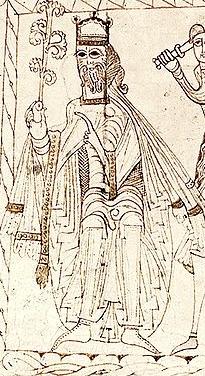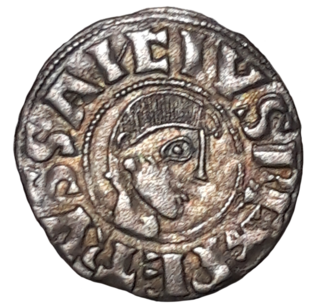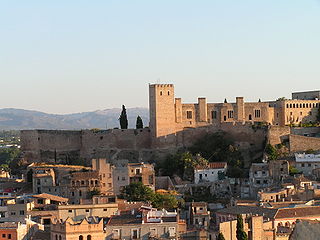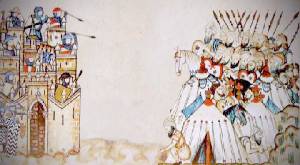
Alfonso I, called the Battler or the Warrior, was King of Aragon and Navarre from 1104 until his death in 1134. He was the second son of King Sancho Ramírez and successor of his brother Peter I. With his marriage to Urraca, queen regnant of Castile, León and Galicia, in 1109, he began to use, with some justification, the grandiose title Emperor of Spain, formerly employed by his father-in-law, Alfonso VI. Alfonso the Battler earned his sobriquet in the Reconquista. He won his greatest military successes in the middle Ebro, where he conquered Zaragoza in 1118 and took Ejea, Tudela, Calatayud, Borja, Tarazona, Daroca, and Monreal del Campo. He died in September 1134 after an unsuccessful battle with the Muslims at the Battle of Fraga.

The Reconquista or the reconquest of al-Andalus was the successful series of military campaigns that European Christian kingdoms waged against the Muslim kingdoms following the Muslim conquest of the Iberian Peninsula by the Umayyad Caliphate. The beginning of the Reconquista is traditionally dated to the Battle of Covadonga, in which an Asturian army achieved the first Christian victory over the forces of the Umayyad Caliphate since the beginning of the military invasion. Its culmination came in 1492 with the fall of the Nasrid kingdom of Granada to the Catholic Monarchs.

Alfonso VII, called the Emperor, became the King of Galicia in 1111 and King of León and Castile in 1126. Alfonso, born Alfonso Raimúndez, first used the title Emperor of All Spain, alongside his mother Urraca, once she vested him with the direct rule of Toledo in 1116. Alfonso later held another investiture in 1135 in a grand ceremony reasserting his claims to the imperial title. He was the son of Urraca of León and Raymond of Burgundy, the first of the House of Ivrea to rule in the Iberian peninsula.

Peter I was King of Aragon and also Pamplona from 1094 until his death in 1104. Peter was the eldest son of Sancho Ramírez, from whom he inherited the crowns of Aragon and Pamplona, and Isabella of Urgell. He was named in honour of Saint Peter, because of his father's special devotion to the Holy See, to which he had made his kingdom a vassal. Peter continued his father's close alliance with the Church and pursued his military thrust south against bordering Al-Andalus taifas with great success, allying with Rodrigo Díaz de Vivar, known as El Cid, the ruler of Valencia, against the Almoravids. According to the medieval Annales Compostellani Peter was "expert in war and daring in initiative", and one modern historian has remarked that "his grasp of the possibilities inherent in the age seems to have been faultless."

Ramon Berenguer IIIthe Great was the count of Barcelona, Girona, and Ausona from 1086, Besalú from 1111, Cerdanya from 1117, and count of Provence in the Holy Roman Empire, from 1112, all until his death in Barcelona in 1131. As Ramon Berenguer I, he was Count of Provence in right of his wife.
The Banu Ghaniya were a Massufa Sanhaja Berber dynasty and a branch of the Almoravids. Their first leader, Muhammad ibn Ali ibn Yusuf, a son of Ali ibn Yusuf al-Massufi and the Almoravid Princess Ghaniya, was appointed as governor of the Balearic Islands in 1126. Following the collapse of the Almoravid power at the hand of the Almohads in the 1140s, the Banu Ghaniya continued to govern the Balearic Islands as independent emirs until about 1203, with a brief interruption in the 1180s. Later leaders made a determined attempt to reconquer the Maghreb, taking Bougie, Constantine and Algiers, and conquering most of modern Tunisia from about 1180 onwards.
This is a timeline of notable events during the period of Muslim presence in Iberia, starting with the Umayyad conquest in the 8th century.

The Battle of Uclés was fought on 29 May 1108 during the Reconquista period near Uclés just south of the river Tagus between the Christian forces of Castile and León under Alfonso VI and the forces of the Muslim Almoravids under Tamim ibn-Yusuf. The battle was a disaster for the Christians and many of the high nobility of León, including seven counts, died in the fray or were beheaded afterwards, while the heir-apparent, Sancho Alfónsez, was murdered by villagers while trying to flee. Despite this, the Almoravids could not capitalise on their success in the open field by taking Toledo.
Ermengarde, was a viscountess of Narbonne from 1134 to 1192. She was the daughter of Aimery II of Narbonne and his first wife, also named Ermengarde.

The County of Pallars Jussà or Lower Pallars was a county in the Hispanic March during the eleventh and twelfth centuries, long after the march had ceased to be effectively administered by the Kings of France. It was a division of the County of Pallars, which had been de facto, and possible de jure, independent since the late ninth century. It roughly corresponded with the modern Catalan comarca of Pallars Jussà.
Aimery II was the Viscount of Narbonne from around 1106 until his death.

The Battle of Sagrajas, also called Zalaca or Zallaqah, was fought between the Almoravid army led by their King Yusuf ibn Tashfin and an army led by the Castilian King Alfonso VI. The Almoravids responded to the call of Jihad by the taifas which commonly fought amongst themselves however they had united to battle the powerful Christian states to the north. The Taifas aided the Almoravids during the battle with troops, favoring the battle for the Muslim side. The battleground was later called az-Zallaqah because of the poor footing caused by the tremendous amount of bloodshed that day, which gave rise to its name in Arabic.

The Battle of Cutanda took place in June 1120 between the forces of Alfonso I the Battler and an army led by Almoravid general Ibrahim ibn Yusuf occurring in a place called Cutanda, near Calamocha (Teruel), in which the Almoravid army was defeated by the combined forces, mainly of Aragon and Navarre.
Guy de Lons, also known as Gui or Guido de Loth, was the Bishop of Lescar from 1115 to 1141. He made extensive travels in Spain on four occasions, three as Papal legate. He began construction on the extant Lescar Cathedral in 1120.

The Battle of the Puig of 1237, also known as the Battle of the Puig de Santa Maria, the Battle of the Puig de Enesa, or the Battle of the Puig de Cepolla was a battle of the Iberian Reconquista and of the Aragonese Conquest of Valencia.

The siege of Tortosa was a military action of the Second Crusade (1147–49) in Spain. A multinational force under the command of Count Raymond Berengar IV of Barcelona besieged the city of Tortosa, then a part of the Almoravid Emirate, for six months before the garrison surrendered.

This chronology presents the timeline of the Reconquista, a series of military and political actions taken following the Muslim conquest of the Iberian Peninsula that began in 711. These Crusades began a decade later with dated to the Battle of Covadonga and it ended Its culmination came in 1492 with the Fall of Granada to Isabella I of Castile and Ferdinand II of Aragon. The evolution of the various Iberian kingdoms to the unified kingdoms of Spain and Portugal was key to the conquest of al-Andalus from the Moors.
The Battle of Valencia in 1130 was a military engagement between the Almoravids and the Aragonese near Valencia. The Almoravids were victorious.

The Siege of Aledo was one of the many battles in the conflict between the Almoravids and the Taifa kingdoms on one side, and the Kingdom of Castile on the other, in the Andalusian region.

The Crusade of Alfonso I of Aragon in Andalusia was a campaign carried out for nine months by Alfonso I the Battler in the interior of al-Andalus, where he camped for a long time near Granada, he plundered fields and riches, he defeated the Almoravid army in pitched battle in Arnisol Anzur, near Puente Genil, south of the current province of Córdoba) and rescued a contingent of Mozarabics with which he repopulated the lands of the Ebro Valley recently conquered by the kingdom of Aragon. The initial objective was to establish a Christian principality in Granada, relying on the Mozarabic population that had insistently requested help from the king of Aragon, as it was subject to the religious fanaticism of the Almoravid period. The Mozarabs of Granada proposed to Alfonso the Battler an internal rebellion against the ruling authority with the support of the Aragonese host; The conjunction was necessary, since Alfonso I, unlike the strategy used in the conquest of Zaragoza in 1118, did not bring assault machinery to Granada, a transport that was in any case extremely impracticable given the long distance that the expedition would travel and the logistical difficulties involved in penetrating so deeply into enemy territory.















